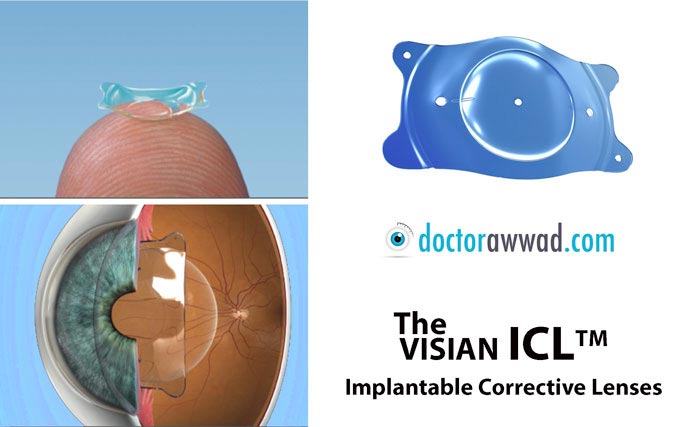Implantable collamer lenses, also known as implantable contact lenses, are FDA approved lenses designed to correct myopia, (up to – 18 D), astigmatism (up to 6 D), and high hyperopia (up to + 8 D). They are made of a proprietary collamer material that is inert to the human body.
How is the ICL implantation performed?
A tiny incision is made in the eye at the periphery of the cornea, the implantable lens is then inserted through the incision and is unfolded inside the eye, then it is positioned in front of the eye’s natural lens, where it provides the needed correction to focus light more accurately on the retina.
Implantable collamer lenses versus LASIK/LASER surgery
Implantable collamer lenses provide superior contrast sensitivity in higher correction compared to many laser procedures, without inducing dry eyes. Several studies have shown improvement in quantitative and qualitative vision in patients with high myopia, high astigmatism, and high hyperopia. Implantable corrective lenses have an exclusive niche when the visual error is beyond what can be achieved with LASIK or LASER surface ablation, or when an individual is not a good candidate for the latter procedures, like in thin corneas and marked dry eyes. LASIK or LASER surface ablation can still be performed on an eye that has previously been implanted with a corrective lens.
[Know your options: LASIK, PRK, & ICL video]
Benefits of Implantable Collamer Lens
In many patients with high correction such as highly myopic patients, implantable corrective lenses often provide superior vision to eyeglasses or contact lenses. This is due to the fact that high power eyeglasses and contact lenses carry large inherent optical and chromatic aberrations, which is usually minimal in implantable lenses. Patients who already suffer from dry eyes and who would rather not wear eyeglasses are at an increased risk when using contact lenses, as the latter equally lead to dry eyes. Complications include severe discomfort, foreign body sensation, redness, and most importantly, infections. LASIK/PRK procedures can potentially worsen the dry eyes condition in those patients, while implantable corrective lenses usually do not cause dry eyes and are the best option in this scenario. Many patients develop chronic contact lens allergy (e.g. giant papillary conjunctivitis) or contact lens induced corneal hypoxia, and are instructed to avoid contact lens wear. Alternatives include implantable lenses or LASIK/PRK.
Safety
The risks of the implantable collamer lenses are fortunately very rare and usually treatable without permanent deficit. Implantable corrective lenses can rarely cause cataract, which is decrease in transparency of the eye’s natural lens (crystalline lens). This condition can develop during surgery, or within few months or several years later. In many cases, this condition is mild and not clinically significant, in which case no intervention is required. In others, vision might still be unaffected or mildly affected, so the implanted lens is removed with no additional consequence. In rare cases, vision is appreciably affected and the implanted lens is removed and a cataract surgery is performed at the same setting. Fortunately, a final artificial lens is usually implanted, and far vision is often restored without the need for eyeglasses. Low power eyeglasses might however be needed to improve near vision as accommodation for near might be affected.
Rarely, the implanted lens is oversized or undersized vis-à-vis the eye anatomic parameters, necessitating exchange with a bigger or smaller size lens. Additionally, the eye pressure can increase postoperatively albeit temporarily and is usually succesfully controlled by pressure lowering eye drops. An internal reaction can very rarely develop against the implanted lens, in which case explantation is necessary.
How to prepare for ICL surgery
Candidates for the procedure need to undergo a full eye exam with pupil dilatation, as well as a battery of tests including corneal topography and thickness testing. As in LASIK or LASER surface ablation surgery; contact lens wear should be discontinued for at least 3 days and sometimes up to one to two weeks as per your doctor’s instructions. Based on the gathered data, the lens is then manufactured and shipped over. The waiting time between lens ordering and arrival is usually several weeks, and can sometimes take up to 6 weeks. Contact lenses can be resumed during this time, but need to be discontinued the day of surgery. The procedure is performed under topical local anesthesia in an operating room setting to maintain optimum aseptic techniques. Although both eyes can be done at the same time, it is preferable to do them separated by a few days. Appreciable visual acuity is regained right after the procedure and keeps improving within a day or two at most, so the rehabilitation time is very short and patients can perform normal social and work activities same day to next day.
Postoperative guidelines & expectations
Important postoperative visits include same day, the first day, and within 4-7 days. There are steroid and antibiotic eye drops, which need to be instilled inside the operated eye for the first several weeks. No eye rubbing is allowed for one month, direct water contact to the eye should be avoided for one week, and swimming should be avoided for one month. Bending over, or lifting heavy objects should be avoided for one week. Light exercising such as jogging can be resumed the second day and regular sports activity after one week.

